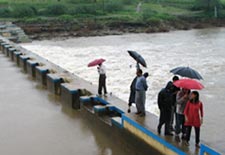| |
A yatra to green villages
10-days on the road, following a circuitous route in Saurashtra through
changing terrains, peeking into the life of villages along the way.
25 people from various regions of our country, and some from abroad,
travelling by road together. How to describe us? Students, NGO people,
journalists, farmers and engineers. Muslims, Hindus, Christians. Adivasis
and Europeans. You may wonder, what brought us together? What took
us there?
What kept us together?
A common concern: water.
As we traveled from Dahod near the Madhya Pradesh (MP) border to Surendranagar,
and on through Rajkot and Junagadh districts down to the coast, and
back via Bhavnagar to Ahmedabad, we witnessed a kaleidoscope of approaches
and techniques to manage water. Different conditions and needs had
brought into play local initiatives and adaptations. We visited a
dozen villages; each day brought a new picture.
 |
|
The issues people were dealing with and the approaches changed as
we moved deeper into Saurashtra. In some places it was a local NGO
that worked to create awareness, helped in building up village institutions
and contributed funds; in others the villagers themselves had undertaken
massive works to revive and manage their water sources.
- In Dahod we saw local lift-irrigation societies managing the
use of water from a river revived and checked by small dams, wastelands
turned into fruit-bearing orchards and drip-irrigated floriculture.
- In caste-ridden drought-prone Surendranagar district women talked
to us about how they now had enough drinking water after installing
roof-top rainwater harvesting systems. We learnt about watershed
development through community institutions, and the need for decentralised
drinking water supply schemes.
- In Rajkot we saw with our own eyes how an ex-Sarpanch had used
satellite imagery to increase the recharge of water and subsequent
filling of wells in his village. Shamjibhai Antala, the tireless
crusader for water showed us his unique method of well-recharging.
- In the Meghal river basin, Junagadh the Aga Khan Rural Support
Programme (AKRSP) despairing of ever solving the problem of dipping
water tables through isolated interventions undertook a river
basin approach to revive a system of rivers and streams, spreading
awareness and knowledge through basin-wide teams of villagers.
Down by the coast we encountered the problems of salinity ingress
due to over-exploitation of groundwater. Pani samiti (water committees)
were involved in the management and prevention of salinity ingress
through such techniques as well sealing, farm bunding and rooftop
rainwater harvesting.
- In Bhavnagar we visited Khopala where a community initiative
to harvest rainwater was led by a diamond merchant who had migrated
from that very village to Surat years before. We witnessed their
pioneering work in building checkdams, practically creating their
own water bearing streams by digging canals around the village.
- The last day we spent in Ahmedabad, talking to Sanjay Joshi
of Centre for Environment Education (CEE), a Ahmedabad based NGO
who had been working on drinking water supply schemes in Bhavnagar
that was a government- NGO collaboration. He shed some light on
the various problems and pleasures that are part of working in
villages, with the attendant issues of caste, gender, corruption
on one side, and the enthusiasm and sense of unity that water
created on the other. We ended our day in Ahmedabad with a visit
to the revived Vastrapur lake, a part of the initiative by local
land-owning municipal bodies to revive urban water bodies.
The Pani Yatra ended with a train ride to Delhi, animated by discussions
on the social issues that are tied to "project work", with
yatris taking turns to play the roles of the various actors involved
- government, NGO, contractor, farmer etc. Back at the CSE office,
the yatris shared their experiences and a few photographs with the
staff.
For more details:
Sumita Dasgupta & Ruksan
Bose
|
|






